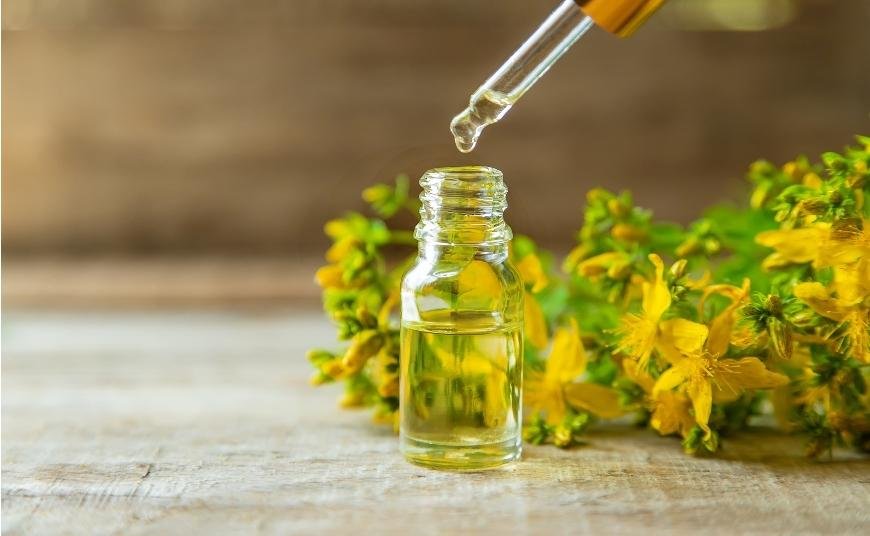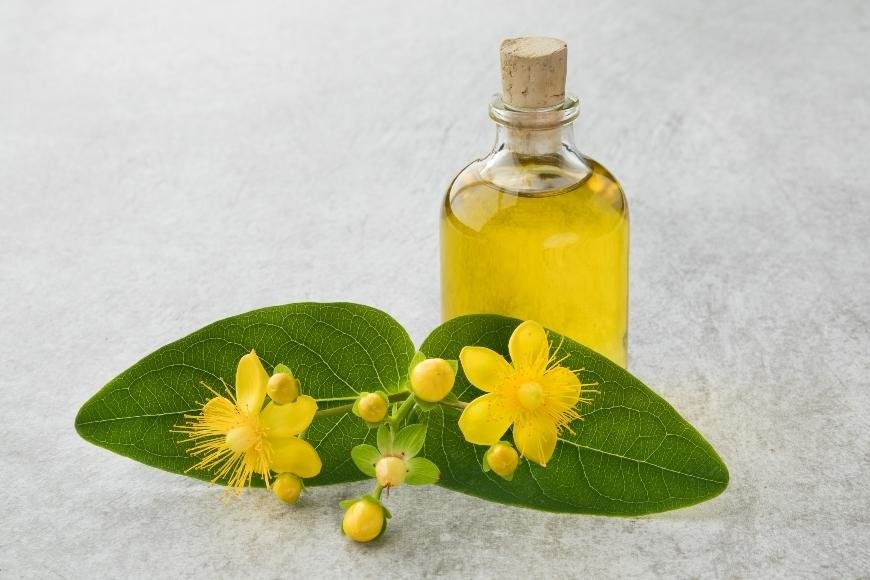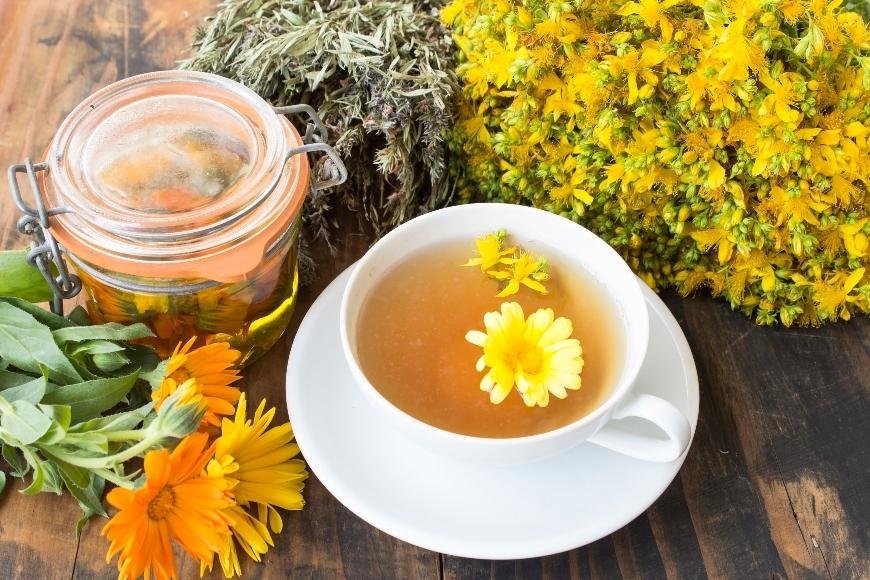How to Make an St John's Worth Extract
Learning how to make an St John's Worth extract can be a rewarding and beneficial skill for those interested in natural remedies.

Learning how to make an St John's Worth extract can be a rewarding and beneficial skill for those interested in natural remedies. In this blog post, we'll provide a comprehensive guide to crafting your own St John's Wort extract from Hypericum perforatum plants.
We'll begin by discussing what exactly St John's Wort extract is and its various uses. Then, we'll delve into gathering materials needed for extraction, preparing the plant material, and executing the extraction process itself.
Moreover, our step-by-step guide will also cover filtering and concentrating the extracted product to ensure potency. Additionally, we will provide tips on proper storage and preservation techniques to maintain the effectiveness of your homemade herbal supplement.
Last but not least, safety considerations are crucial when working with any kind of herbal products; therefore, we will highlight essential precautions while making and taking St John's Worth extract. So get ready to embark on this journey towards creating your very own potent herbal remedy!
Table of Contents:
- What is St John's Wort Extract?
- Why Make an Extract?
- Gathering Materials
- Extraction Process
- Filtering and Concentrating
- Storage and Preservation
- Safety Considerations
- Frequently Asked Questions How to Make an St John's Worth Extract
- Conclusion
What is St John's Wort Extract?

St John's Wort extract is a concentrated form of the active compounds found in the St John's Wort plant, a popular herb known for its medicinal properties. For centuries, this plant has been utilized to address an array of conditions, including despondency, tension and inflammation. By creating an extract from this versatile herb, you can harness its full potential and enjoy its numerous benefits.
Why Make an Extract?
Making an extract allows you to concentrate the beneficial compounds found in St John's Wort into a more potent form. This means that you can use smaller amounts of the substance while still experiencing its therapeutic effects. Additionally, extracts are often easier to consume than raw plant material - they can be added to teas or tinctures or even applied topically as needed.
The Active Compounds
The primary active compounds in St John's Wort are hypericin and hyperforin. These substances have been shown to possess antidepressant properties by acting on neurotransmitters such as serotonin and dopamine within the brain (source). Furthermore, these components also exhibit anti-inflammatory and antimicrobial activities which contribute significantly towards their overall health benefits.
Potential Benefits
- Depression: Research suggests that St. Johns Wort may help alleviate mild-to-moderate depressive symptoms by increasing levels of certain neurotransmitters like serotonin (source).
- Anxiety: Some studies have shown that St John's Wort may help reduce anxiety and stress by modulating the brain's response to stress hormones (source).
- Inflammation: The anti-inflammatory properties of St Johns Wort make it a useful remedy for various inflammatory conditions, such as arthritis or muscle pain.
- Skin Health: Due to its antimicrobial and anti-inflammatory effects, topical application of St. Johns Wort extract can promote wound healing and improve skin health in cases of minor burns, cuts, or abrasions (source).
Now that you understand the benefits of creating an extract from this powerful herb let's explore how to make your own at home.
Gathering Materials
Before diving into the process of making your own St John's Wort extract, it's essential to gather all the necessary materials. Having everything prepared and within reach will make the extraction process smoother and more enjoyable. Here is a list of items you'll need:
- Fresh or dried St John's Wort flowers: You can either harvest them yourself from wild plants or purchase them online from reputable sources.
- A solvent: High-proof alcohol (such as vodka) works best for this purpose, but vegetable glycerin can also be used if you prefer an alcohol-free option.
- A glass jar with a tight-fitting lid: This will be used to store your plant material and solvent during the extraction process. Make sure it is clean and sterilized before use.
- Cheesecloth or fine mesh strainer: These are essential for filtering out any solid plant matter after extraction.
- A funnel: This helps transfer your filtered extract into smaller storage containers without spilling any precious liquid along the way.
- Amber glass dropper bottles: Perfect for storing, measuring, and administering your finished St John's Wort extract. They also protect against light degradation. You can find these at stores like Amazon or speciality shops such as Zamnesia.
In addition to these basic materials, having some gloves on hand may prove useful when handling fresh plant material since some people experience skin irritation from contact with St John's Wort. A pair of scissors or garden shears will also come in handy for cutting and preparing the plant material before extraction.
Gathering the necessary materials for this project is a crucial step in ensuring that you have everything needed to make an extract of St. John's Wort. The next heading will discuss how to prepare your plant material before beginning the extraction process.
Preparing the Plant Material
Before you can create your own St John's Wort extract, it is essential to properly prepare the plant material. This ensures that you obtain a high-quality and potent extract. Follow these steps for optimal results:
- Gathering St John's Wort: The best time to harvest St John's Wort is during its flowering season, which typically occurs between June and August. Look for plants with bright yellow flowers and healthy green leaves. To ensure potency, try to gather fresh plant material in the morning after any dew has evaporated.
- Cleaning: Once you have collected enough plant material, gently rinse it under cold water to remove dirt or debris. Be careful not to damage the delicate flowers while cleaning them.
- Drying: If possible, allow your freshly harvested St John's Wort to air dry for several hours before proceeding with extraction. This will help prevent mold growth during storage and make it easier for the active compounds (hypericin) within the plant matter to be extracted later on.
- Chopping: To maximize surface area exposure during extraction, finely chop or grind your dried St John's Wort using a sharp knife or a herb grinder like this one from our friends at Azarius (Herb Grinder). The smaller pieces will facilitate better absorption of solvents into the plant tissue.
In addition to preparing fresh St. Johns Wort as described above, you may also choose to use commercially available dried herbs instead if harvesting wild plants isn't feasible in your location or timeframe. If opting for pre-dried St John's Wort, ensure that you purchase from a reputable source to guarantee quality and potency. Check out our recommended dried St John's Wort for your extraction needs.
Preparing the plant material is a crucial step in making an St John's Wort extract, as it ensures that only the most potent parts of the plant are used. Having established the importance of prepping the plant material, we can now move on to examining how to carry out the extraction process properly.
Extraction Process
Harnessing the power of St John's Wort begins with an extraction process. This section will guide you through a simple yet effective method for extracting the active compounds from your prepared plant material.
Choosing Your Solvent
To extract the beneficial compounds from St John's Wort, you'll need a solvent. The most common solvents used are alcohol (ethanol), vegetable glycerin, or apple cider vinegar. Ethanol, being able to dissolve both hydrophilic and lipophilic components in plants, is frequently favored for its superior extraction efficiency.
Maceration Method
- Weighing: Weigh out approximately 100 grams of dried St John's Wort flowers and leaves using a digital scale.
- Solvent Preparation: Mix your chosen solvent with an equal amount of distilled water if using alcohol or glycerin. For example, if 500ml of alcohol is the solvent of choice, combine it with an equivalent quantity of distilled water before continuing.
- Mixing Plant Material & Solvent: Place the weighed-out plant material into a large glass jar with an air-tight lid. Pour enough solvent mixture over it until all parts are completely submerged by at least one inch above them.
- Aging Process: Seal the jar tightly and store it in a cool dark place for about four weeks while shaking daily during this period - this helps release more active ingredients into solution.- Filtering: After maceration time has passed, strain out solids using cheesecloth or fine mesh strainer into another clean jar/container. Press plant material gently to extract as much liquid possible before discarding it.- Evaporation (Optional): If desired concentration isn't achieved yet due alcohol content being too high still after filtering step above then consider evaporating some off by leaving lid slightly ajar allowing evaporation occur naturally over several days until reached desired potency level.
Now that you've successfully extracted the active compounds from St John's Wort, you're ready for the next step: filtering and concentrating your extract. Follow along in our Filtering and Concentrating section to learn how to refine your homemade St John's Wort extract even further.
Filtering and Concentrating
Now that you've successfully extracted the active compounds from St John's Wort, it's time to filter and concentrate your extract. This process is crucial for obtaining a pure, potent product that can be easily stored and used later on.
Filtration
To begin filtering your extract, you'll need some basic equipment like a filtration apparatus, coffee filters or cheesecloth, and a funnel. Start by placing the filtration material (coffee filter or cheesecloth) inside the funnel. Then slowly pour your liquid extract through the filter into another container.
- If using a coffee filter: Replace with fresh filters as they become clogged with plant residue to ensure smooth filtration.
- If using cheesecloth: Gently squeeze out any remaining liquid trapped in the cloth after each pass-through of extraction solution.
This step may take some time but will result in an impurity-free liquid containing all of St John's Wort's essential components.
Concentration
The next step is concentrating on your filtered extract to increase its potency. There are two main methods for doing this:
- Evaporation: Place your filtered liquid in a shallow dish or tray under low heat (around 40°C). The goal here is not to boil off water content but rather allow it to evaporate gradually over several hours or even days until only concentrated oil remains behind.
Note: Be cautious when applying heat near flammable substances such as alcohol-based extractions. - Freeze-drying: This method involves placing your filtered liquid in a freeze dryer, which will remove water content by sublimation. The end product is a highly concentrated powder which can be kept or reconstituted when necessary.
Note: Freeze dryers are expensive pieces of equipment, so this option may not be feasible for everyone.
Once you've successfully concentrated your St John's Wort extract, it's ready to be used or stored for future use. Remember always to label your containers with the date and concentration level to keep track of potency over time.
Filtering and concentrating are important steps to take when making an extract of St John's Wort, as they ensure that the final product is safe and effective. Moving on, proper storage and preservation techniques should be employed in order to maintain the quality of the extract over time.
Storage and Preservation
Once you have successfully created your St John's Wort extract, it is essential to store and preserve it correctly to maintain its potency and effectiveness. In this section, we will discuss the best practices for storing your homemade extract.
Glass Containers
It is recommended to use dark amber glass containers with airtight lids for storage. The dark color helps protect the extract from light exposure, which can degrade its active compounds over time. Additionally, glass does not react with the constituents of the extract as some plastics might.
Avoid Heat and Light Exposure
To ensure the potency of your St John's Wort extract, store it in a cool, dark location away from heat and light. Excessive heat can cause evaporation of volatile components while light exposure may lead to degradation of active ingredients.
Label Your Extracts
- Date: Make sure to label each container with the date you made the extraction so that you know how long it has been stored.
- Type: Clearly indicate if your St John's Wort extract is alcohol-based (tincture) or oil-based (infused oil), as they may require different usage methods depending on their intended purpose.
- Dosage Information: Include any relevant dosage information based on personal experience or research so that others who may use your extracts are aware of proper usage guidelines.
Tinctures: Shelf Life Considerations
An alcohol-based tincture can last up to several years if stored appropriately, though it is essential to regularly inspect for spoilage. Regularly inspect your St John's Wort tincture for any signs of spoilage or deterioration, taking note of its scent and appearance.
Infused Oils: Shelf Life Considerations
Oil-based extracts have a shorter shelf life compared to alcohol-based ones, usually ranging from 6 months to 1 year. To extend their longevity, consider adding vitamin E oil, which acts as a natural preservative due to its antioxidant properties. Regularly inspect infused oils for changes in odor or consistency that may indicate spoilage.
By following these storage and preservation guidelines, you can ensure that your homemade St John's Wort extract remains potent and effective for future use.
Proper storage and preservation of St John's Wort extract is essential to ensure its potency and quality. Therefore, it is important to consider safety considerations when handling the extract.
Safety Considerations

While making and using St John's Wort extract can be an exciting and rewarding experience, it is essential to keep safety in mind. This section will discuss some important safety considerations when working with this plant.
Potential Side Effects
St John's Wort is generally considered safe for most people; however, it may cause side effects such as dry mouth, dizziness, headache, or gastrointestinal symptoms. It is crucial to start with a low dose of the extract and gradually increase it while monitoring your body's reaction.
Drug Interactions
This herb has been known to interact with several medications due to its effect on liver enzymes responsible for drug metabolism. Some common drugs that may have interactions include antidepressants (SSRIs), birth control pills, anticoagulants (warfarin), and HIV medications. Always consult your healthcare provider before starting any new supplement or herbal remedy if you are taking prescription medication. For more information on potential drug interactions with St John's Wort, visit this drug interaction checker.
Allergic Reactions
- Skin Sensitivity: Some individuals might develop skin sensitivity or allergic reactions after handling St Johns Wort plants directly. To avoid contact dermatitis or other skin irritations caused by the plant material itself during extraction preparation process wear gloves.
- Ingestion Allergies: If you have a known allergy to plants in the Hypericaceae family, it is best to avoid using St John's Wort extract as it may cause an allergic reaction.
Pregnancy and Breastfeeding
St John's Wort is not recommended for use during pregnancy or breastfeeding due to limited research on its safety. It has been shown that the active compounds can pass through breast milk, potentially affecting infants. Nursing or expecting mothers should seek advice from their healthcare provider prior to using any herbal remedies.
Sun Sensitivity
The active compound hypericin found in St Johns Wort can make your skin more sensitive to sunlight (photosensitivity). When using this extract, be cautious about sun exposure and wear sunscreen with high SPF protection when outdoors.
In conclusion, always prioritize safety while making and consuming St John's Wort extract by being aware of potential side effects, drug interactions, allergies, and other precautions. By following these guidelines and consulting your healthcare professional if needed, you will ensure a safe experience with this natural remedy.
Frequently Asked Questions How to Make an St John's Worth Extract
How do you make St John's wort extract?
To make St John's Wort extract, follow these steps: gather fresh or dried plant material, prepare the plant by cutting it into small pieces, use a solvent like alcohol or oil for extraction, let the mixture sit for several weeks while shaking occasionally, filter and concentrate the liquid to desired potency. Store in a dark container away from sunlight.
How do you extract oil from St John's wort?
To extract oil from St John's Wort, infuse chopped plant material in carrier oils such as olive or almond oil. Place the mixture in a jar with an air-tight lid and store it in a warm place away from direct sunlight for 4-6 weeks. Shake daily to help release active compounds. Afterward, strain out the solid materials using cheesecloth and transfer the infused oil into dark glass bottles.
What is the most effective way to take St Johns Wort?
The most effective way to take St Johns Wort depends on individual preferences but common methods include capsules containing standardized extracts (300mg per capsule), tinctures taken under tongue (20-30 drops), teas made with dried herb (1 teaspoon steeped for 10 minutes) or topical application of infused oils. Consult your healthcare provider before starting any herbal supplement regimen.
Conclusion
Preparing a distillate from St John's Wort can be an excellent method for harnessing the plant's potency. By following the simple instructions in this guide, you can easily create an extract of St John's Wort that is both safe and effective to store for future use. Remember to always take safety precautions when making any kind of extract, especially with herbs like St John's Wort which can be quite potent. With these tips on how to make an St John’s Worth Extract, you should now feel confident in creating your own herbal extracts.






































































































































